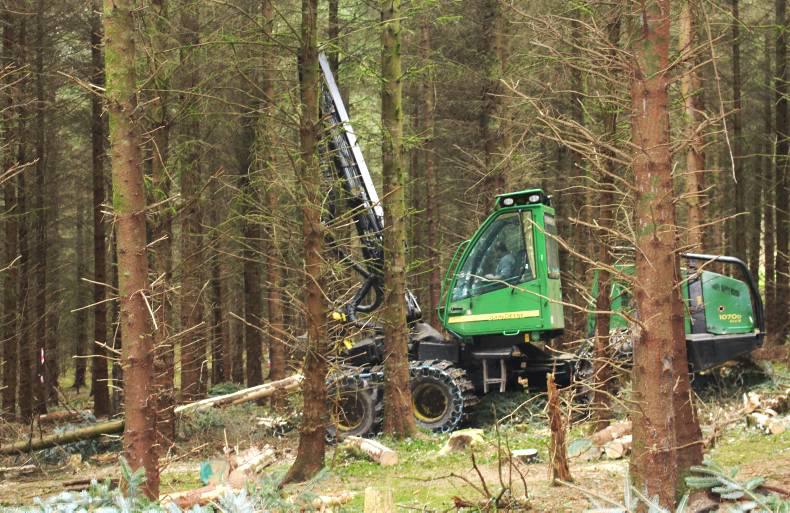Nearly 20,000 private forest owners have received grant aid to establish forests since 1980. Returns from forestry are strongly competitive compared with many of the other farm enterprises. Potential forestry returns, along with positive interactions with key farm schemes, have the potential to enhance financial fitness on the farm.
Other farm systems
The year-on-year change in income varied across the farm systems. Total production costs declined across all farm systems in 2014. However, the reduction in expenditure was insufficient to offset the falling finished cattle price for ‘cattle other’ farms (predominantly cattle fattening).
In fact, the largest income reduction is on “cattle other” farms, where income was down 12% (Hennessy, T. and Moran, B. 2015).

When considering the average gross margin (ie gross output less variable costs) per hectare (€/ha) produced by the various farm systems in recent years (Figure 1), it makes good sense that cattle and sheep farmers on marginal agricultural land are considering the forestry option as a means of income enhancement.
A review of the average subsidy payment per farm and the contribution to income across the various farm systems indicates that cattle-rearing farms have the lowest subsidy payment at €15,412 on average.
Subsidies comprise the largest proportion of income (149%) on this farm system, followed by “cattle other” (137%) and sheep (123%).
The total subsidy payment comprises Single Farm Payment (SFP) and payments relating to the Disadvantaged Area Scheme (DAS), Rural Environmental Protection Scheme (REPS) and the newer Agri-Environmental Scheme (AEOS).
In order to broadly compare forestry with other farm enterprise options, different forest crop rotations can be presented on an annual per hectare basis.
This can be done by expressing the net present value (NPV) of a forestry plantation as a series of equal cashflows over the forest rotation length, known as the annual equivalent value (AEV).
This indicative AEV figure on a per hectare basis can then be used for broad comparison purposes with the gross margin (minus SFP/BPS) per hectare per year for other farming enterprises.
Even for a single tree species, the AEV figure will vary according to growth rate, rotation length, management history, etc.
For example, the AEV for Sitka spruce at yield class (YC) 24 (m3/ha/per annum) could be as high as €602/ha, while the AEV for Sitka spruce at YC 16 could be €415/ha (Table 1).
These are indicative values and calculations are based on premium and timber sales revenues minus costs, including inspection paths, maintenance, insurance, roading and reforestation.
These figures do not take into account that the SFP/ BPS can also be drawn down on eligible forestry ground.
The largest financial returns arise where forestry replaces cattle systems on land that is limited for agriculture due to poor drainage, but can produce at least a YC 18 Sitka spruce crop, and where sheep systems are replaced on land that is very limited for agriculture, but can produce at least a YC 14 forestry crop (Ryan et al., 2013).
Factors to plant
The general trend across all systems is for the competitiveness of forestry to increase as soil quality for agricultural production decreases, which is a reflection of the robustness of forestry compared with other land uses. However, these comparisons do not take into account the irreversibility of the planting option and the opportunity cost associated with permanent land use change.
Attitudes towards forestry are strongly linked with land quality and possible alternative land uses and income streams.
Farm schemes
A whole farm planning approach also requires analysis of how planting land may interact with other farming issues, such as stocking rates and nitrate calculations.
The interaction of forestry with other farm schemes and eligibilities is also critical. In general, these interactions are very favourable.
Eligibility for forestry premium payments: The new Forestry Programme 2014-2020 does not differentiate between “farmer” and “non-farmer” premium rates. Enhanced premiums are available to all eligible applicants over a 15-year period to compensate for potential income foregone.
Forestry and the Basic Payment Scheme (BPS): Eligible land planted since 2009 and which will be afforested under the new Forestry Programme 2014-2020 can be used to activate BPS entitlements, subject to similar criteria as previously applied. This is a major advantage for applicants in a position to benefit.
Forestry and Greening: While all farmers are required to comply with greening requirements, the majority will automatically qualify for the Greening payment based on current farming practices (permanent pasture). Existing SPS-eligible forestry and newly planted BPS-eligible forestry can go towards meeting EFA requirements.
Forestry and Early Retirement Scheme (ERS): The ERS is closed to new entrants and the new single category for forest premiums may act as an incentive to retired farmers to plant, particularly where lands they had leased to qualify under the ERS are returned to them.
Forestry and Areas of Natural Constraint (ANC): The ANC scheme has replaced the previous Disadvantaged Area Scheme (DAS) since January of this year. Land classifications under DAS will remain as they are until the 2018 scheme year when new classification criteria are likely to come into effect. The current area threshold for less/more severely handicapped lowland is 30ha, while the equivalent for mountain type grazing is 34ha. Where farm size is above the relevant threshold, there may be opportunities to maximise ANC payment on the threshold area and also plant some remaining land. For farm holdings whose total eligible area is equal to or lower than these thresholds, planting some land would result in a pro-rata reduction in ANC payment.
Forestry and GLAS agri-environmental scheme: GLAS is not a whole-farm scheme. Land parcels not associated with GLAS participation may be considered for the Afforestation Scheme. However, once land parcels are committed to GLAS, they cannot be planted without claw-back of GLAS payments already made. Forward planning is required for potential GLAS applicants, which may allow the planting option to be considered on appropriate land parcels during the GLAS commitment period.
John Casey and Tom Houlihan are forestry development officers with Teagasc Forestry Development Department.
References
Ryan, M., Kinsella, A. and Upton, V. (2013). An examination of studies of the financial and attitudinal factors affecting the farm afforestation decision. A report prepared for the Forest Service, DAFM
Hennessy, T. and Moran, B. (2015). Teagasc National Farm Survey 2014 Results.






 This is a subscriber-only article
This is a subscriber-only article












SHARING OPTIONS: